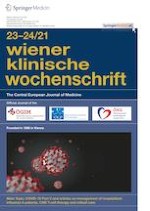Erschienen in:

Open Access
29.10.2021 | consensus report
Point of care echocardiography and lung ultrasound in critically ill patients with COVID-19
verfasst von:
Martin Altersberger, Matthias Schneider, Martina Schiller, Christina Binder-Rodriguez, Martin Genger, Mounir Khafaga, Thomas Binder, Helmut Prosch
Erschienen in:
Wiener klinische Wochenschrift
|
Ausgabe 23-24/2021
Summary
Hundreds of millions got infected, and millions have died worldwide and still the number of cases is rising.
Chest radiographs and computed tomography (CT) are useful for imaging the lung but their use in infectious diseases is limited due to hygiene and availability.
Lung ultrasound has been shown to be useful in the context of the pandemic, providing clinicians with valuable insights and helping identify complications such as pleural effusion in heart failure or bacterial superinfections. Moreover, lung ultrasound is useful for identifying possible complications of procedures, in particular, pneumothorax.
Associations between coronavirus disease 2019 (COVID-19) and cardiac complications, such as acute myocardial infarction and myocarditis, have been reported. As such, point of care echocardiography as well as a comprehensive approach in later stages of the disease provide important information for optimally diagnosing and treating complications of COVID-19.
In our experience, lung ultrasound in combination with echocardiography, has a great impact on treatment decisions. In the acute state as well as in the follow-up setting after a severe or critical state of COVID-19, ultrasound can be of great impact to monitor the progression and regression of disease.